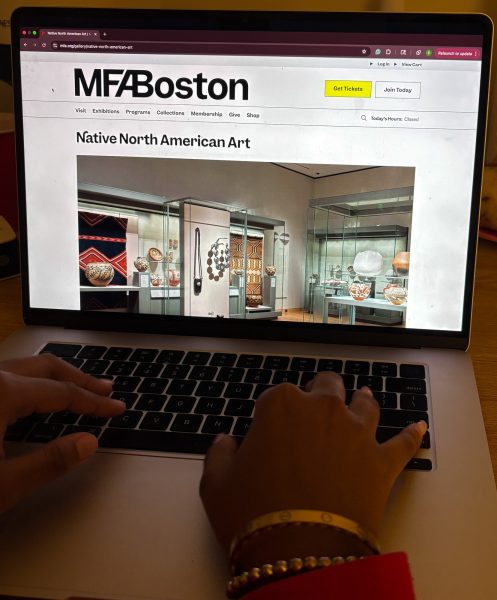Museums around Boston opened their doors to the public Monday with free programs to celebrate Indigenous Peoples’ Day despite efforts by President Donald Trump’s administration to erase the holiday.

“Christopher Columbus has been a prime target of a vicious and merciless campaign to erase our history, slander our heroes, and attack our heritage,” Trump wrote in a proclamation declaring Oct. 13 as Columbus Day.
Despite Trump’s rhetoric, institutions like the Museum of Fine Arts and the Massachusetts Historical Society used the day to honor indigenous culture and history.
Alexandra Moleski, National History Day program coordinator at the MHS, curated the exhibit for Indigenous Peoples’ Day. She said the display represents the seven teachings of the Anishinaabe people — love, respect, courage, wisdom, humility, truth and honesty.
Moleski said curating this exhibit was an opportunity to reconnect with her Penobscot and Wolastoqey heritage.
“I was trying to capture with the exhibit the fact that indigenous knowledge and stories are not just for indigenous folks,” Moleski said. “The concept of the seven teachings is based around this idea that we all are part of the same process of creation.”
Another exhibit featured by the MHS was a digitized manuscript of Wampanoag phrases and their English translations.
The Wampanoag language had no native speakers for over a century, going “silent for over 100 years,” said Ondine Le Blanc, editor of publications at the MHS. Digitizing the document is a meaningful step toward restoring the language, she said.
Le Blanc said the manuscript will be available on the MHS website by the spring. She said she hopes researchers and the general public will have access to the “beautiful” language soon.
“It’s clear that it’s very moving for a lot of people and a really fascinating document,” Le Blanc said.
At the MFA, Indigenous Peoples’ Day was celebrated with gallery tours, family art-making activities, performances, story time and guest speaker talks. Indigenous artists also spoke at the museum about their experiences working with the natural world.
Erica Nelson Menard, a traditional Penobscot basket maker, noted the challenges of gathering traditional materials due to climate change.
“The sweet grass, it’s becoming pretty hard to find,” Menard said. “Some of the artists are looking at alternatives to making baskets from the ash and sweet grass.”
Hawk Henries, a composer and flute player of the Chaubunagungamaug band of Nipmuc, noted the millenia-old indigenous culture in America.
“There are Native people who have been here for thousands and thousands and thousands of years. The idea of America is a little over 270 years old,” Henries said. “There’s 600 plus nations of indigenous people on this continent, each having their own culture, their own languages, their own names.”
Henries said all people and cultures are invaluable, and without their contributions, “life would be dramatically different.”
While Indigenous Peoples’ Day is not recognized federally, Moleski said it’s important for people to “go out of their way” to seek the truth and understand history.
“Whatever day you want to celebrate, the real significance behind it is just knowing the history and the truth,” Moleski said.